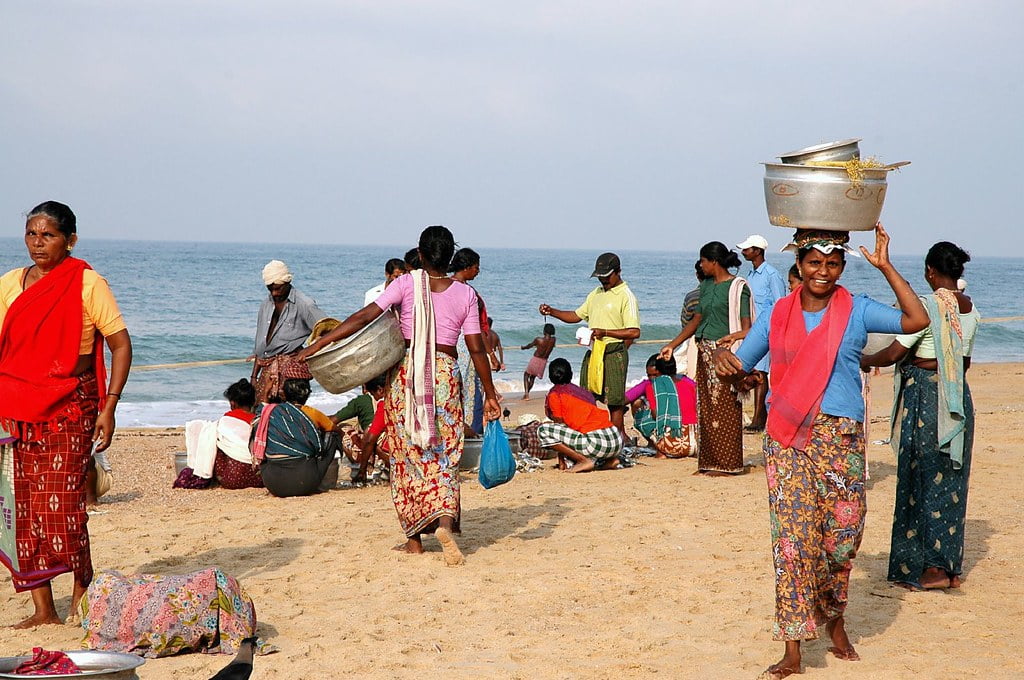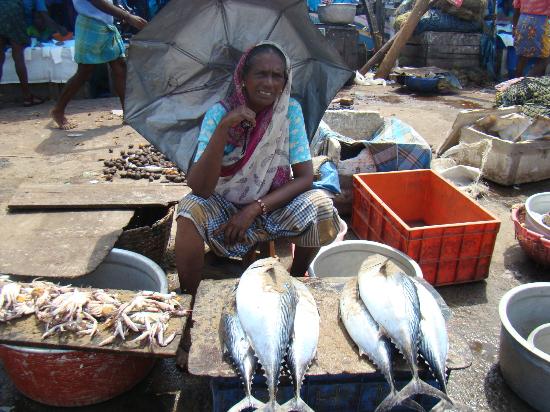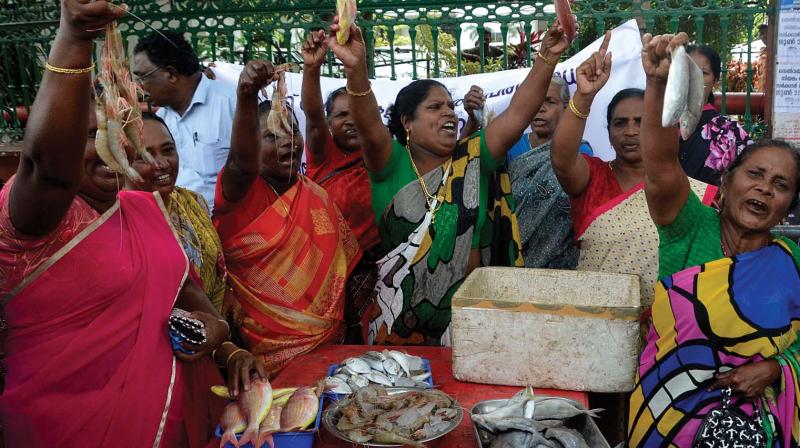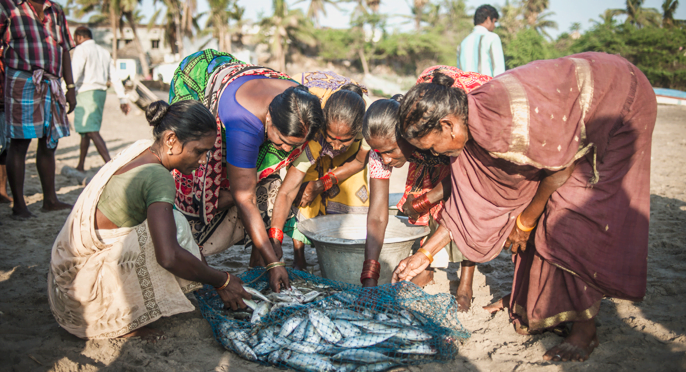Kerala has a coastline of about 590 km., out of which 60% (as of 2017) has been usurped by the government and private companies. Large and small scale projects are implemented on this land (most of them funded by institutions like the Asian Development Bank (ADB) or the World Bank and by the government), with very little regard for environmental norms, and claiming resources that should be available to the community that inhabits these areas. Fishing has been a source of subsistence for traditional fisher folk communities, both for fishermen and fisherwomen, whereby the work done by the latter has been barely acknowledged. With the advent of globalisation and mechanisation, radical changes have come to the sector and to the communities associated with it. Production has shifted from communities to industries.
Globalisation And Its Effects On Coastal Communities
After Independence, it was felt that modernisation and mechanisation of the fishing sector would help increase productive capacity. The Indo-Norwegian Project (INP) – a tripartite agreement signed in 1953 in New Delhi between the United Nations, the Government of India, and the Government of Norway- came to be as an investment by a Social Democratic government in helping a “backward economy”. With the INP, came technological advancements in harvesting processes. These advancements were supposedly meant to promote economic growth and bestow upon these villages for better infrastructure.

The 1960s saw an increase in the international demand for prawns, which encouraged the government to promote export-oriented prawn fisheries. Mechanised boats were built, and fishermen were trained to use trawl nets. Export oriented fisheries and a high rate of investment allowed merchants, financiers and middlemen to slide into the sector, gradually pushing out the traditional fishing community from mechanised fishing. Prolonged periods of mechanised deep sea fishing and aquaculture, also a brought about a multitude of problems ranging from over-fishing, depletion of the oceans, indebtedness of the fish-workers etc. all of which posed an acute threat to the fisheries.
Export oriented fisheries and a high rate of investment allowed merchants, financiers and middlemen to slide into the sector, gradually pushing out the traditional fishing community from mechanised fishing. Prolonged periods of mechanised deep sea fishing and aquaculture, also a brought about a multitude of problems ranging from over-fishing, depletion of the oceans, indebtedness of the fish-workers etc.
The state attempted to carry out the mechanisation program, while simultaneously creating producer cooperatives. Mechanised boats were to be issued only through producer cooperatives to groups of fishermen. However, as John Kurien points out, these cooperatives were often dominated by financiers and middlemen and were the furthest thing from being fishermen organisations.
In order to counter this ‘nexus of exploitation’, communities of artisanal fishermen saw it necessary to organise themselves, and forge linkages. The cooperatives that were formed by the fishermen, differed from the ones created by the government, in that they were run by members of the community and facilitated small repayments, at low interest rates. The Kerala Swatantrata Matsya Thozilali Federation (KSMTF) was one such organisation.

These organisations led to the ‘political awakening’ of the artisanal fishing community. As trade unions and cooperatives cropped up, the coastal communities of Kerala witnessed a barrage of hunger strikes, and demonstrations. Their chief demand was that trawling during monsoon season (breeding season for the fish near the shore) should be banned. Other demands included curbing the pollution of inland water resources, a comprehensive regulation by the Marine Regulation Act and that mechanised boats must not operate 5 km. beyond the coast.
Women: The Worst Affected
There are approximately 5.4 million people engaged in fisheries in India. Women account for 1.6 million, and more than a million come from the 222 fishing villages in Kerala. Most of these women depend on supplementary activities like processing and marketing of fish for survival. However, the conception of the INP was based on the premise that fisherwomen had little to no involvement in the fisheries.

Women in fishing households are traditionally not allowed to go to sea. They look after childcare, and domestic chores. However, most of them were also involved in supporting activities such as head-load fish vending, deferring coconut husks and manual rope making, shell collection, processing, marketing, net-making etc. These activities served as a way for the women to supplement their family income. Taking up any of these activities was considered to be a “loss of status” for the family, and hence, when asked (through surveys, interviews etc), the matter was mostly kept private, leading to an erasure of the work carried out by these women. As a result of this erasure, violence was meted out to women, both on their identity in society and on their physical entity.
These activities served as a way for the women to supplement their family income. Taking up any of these activities was considered to be a “loss of status” for the family, and hence, when asked (through surveys, interviews etc), the matter was mostly kept private, leading to an erasure of the work carried out by these women. As a result of this erasure, violence was meted out to women, both on their identity in society and on their physical entity.
The divide between men and women grew wider. As men from local fishing communities were displaced as fishers and “procurer of produce”, they were still absorbed by the industry as head load workers, agents, fish-sellers, thereby displacing the women. They had greater access to technology and greater mobility within the markets and the villages, which allowed to them to do so.
It was the fisherwomen who sold the catch the men brought in at markets. A fall in fish stocks meant that they would have to procure the produce from elsewhere, deal with the cooperatives, and resist manipulative moneylenders. Less produce meant less income, and less income left them indebted to money lenders. And with the traditional fish markets swallowed by big corporations, they were left all the more vulnerable and insecure. They found themselves having to travel long distances to sell their produce in markets, and yet they were being denied entry on public transport because of their smelly baskets. To add insult to injury, large scale sand mining activities made the water unfit for consumption, forcing women to walk long distances to fetch drinking water.
A loss in productive activity had the men turn to alcoholism and gambling, leading to a spike in cases of wife beating and desertion and sexual harassment.
The Resistance
As women started to collectivise, they started off by getting involved in religious activities and discussions on topics of common interest. The late 1970s-80s saw a rise in the number of women’s organisations in coastal villages. By the end of the 1980s, the women members of KSMTF decided to set up a women’s wing – the Theeradesa Mahila Vedi (TMV). Women like Aleyamma Vijayan, Sister Philomene Mary, Sister Alice and Magline Peter set this movement in motion.
Since its inception, TMV has waged continued resistance against the incessant marginalisation and exploitation of local fishing communities. The one that has been most proudly talked about is their fight for special buses. The women took to the streets, picketed, marched, fasted and organised a strike for about four to five years, until the government relented and provided them with special buses. In fact, the first ever march of the women fish vendors (1979) saw them march with their fish baskets to the secretariat to demand for the right to access public transport.
Also read: Why The Women’s Wall In Kerala Deserves Your Attention
Next on their agenda, demands were placed at the panchayat markets they worked for, for the provision of basic amenities like drinking water, ice boxes, a toilet, a space to change their clothes and protection from the goondas who circulated in these markets. Demonstrations have also been organised to protest unfair tax collection by the contractors. TMV and its members have also stepped in and pursued cases of domestic violence and sexual harassment, that eventually culminated in the arrest of the perpetrator, giving women the confidence to report cases of violence.
demands were placed at the panchayat markets they worked for, for the provision of basic amenities like drinking water, ice boxes, a toilet, a space to change their clothes and protection from the goondas who circulated in these markets. Demonstrations have also been organised to protest unfair tax collection by the contractors.
In 1992, the fisherwomen, along with the fish-workers association, set up thatched huts in front of the secretariat’s office where they cooked food, and slept for 15 days until fisherwomen were included in government schemes offering financial aid and insurance. Not only did this give them added financial security, but also demanded that they be recognised as fish workers by the state.
The Resistance Continues
The resistance by the artisanal fisherfolk community is the epitome of the phrase “one step forward, two step backwards”. Although the fisherwomen were given special buses plying to and from markets, in 2004, they took to picketing the office of the bus administration to discuss the shoddy maintenance of bus operations.
In December 2004, a tsunami swept through coastal communities in Kerala and along with it, income and the ability to access cash for most women. Relief shelters offered very little privacy and sanitation facilities, separate toilets etc., and also put them at the risk of being harassed by men and being overlooked by male doctors.
Also read: The Vaikom Satyagraha: Kerala’s First Anti-Caste Movement
Livelihood programs, focused on the number of boats lost, thereby ignoring the work done by women and were simultaneously excluded from relief measures. In 2017, they carried out a 65 day struggle against the construction of LPG storage plant built by the Indian Oil Corporation in Kochi. Till date, most local fish vendors and hawkers face the threat of eviction by corporate lobbies, “but it is the resistance of the fisherwomen that have kept these forces at bay”.
Featured Image Source: Femina
About the author(s)
Krishna has a masters degree in Development Studies from Azim Premji University, and hopes to establish a career in psychology and counselling. She currently resides in Kochi and is taking time out to recharge - physically, mentally and intellectually. Any suggestion that will aid the recharge process will be received with gratitude and excitement.




